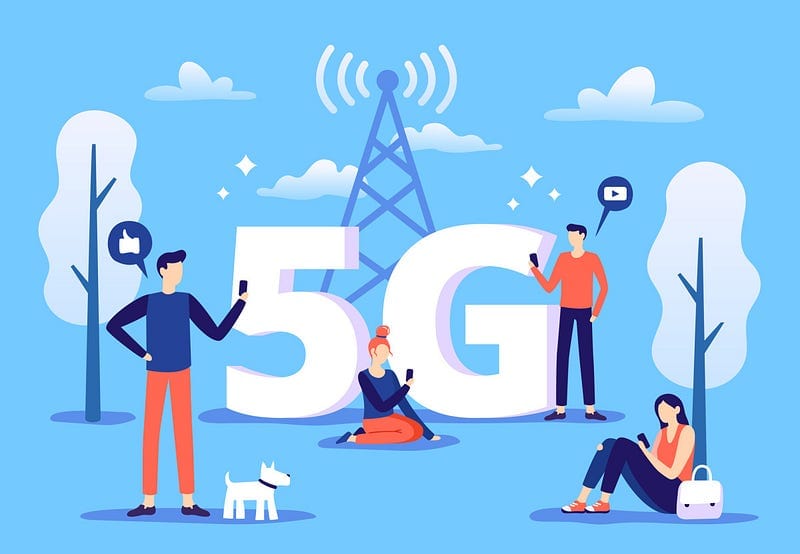The Rise of 5G and Its Impact on the Classroom
As discussed in our Emerging Technologies in the 2020 Classroom report, 5G technology could bring human communication to an entirely new…

As discussed in our Emerging Technologies in the 2020 Classroom report, 5G technology could bring human communication to an entirely new level. The corresponding impact of this type of connectivity on the world of learning and work is imminent and exciting as well. Whether it be virtual learning, mentoring, mobile video-based content creation, or enterprise applications in a district setting, the implications are far-reaching, diverse, and incredibly exciting to consider. Several use cases that are particularly interesting with the advent of 5G connectivity are the further enablement of distance learning, virtual/augmented reality, and media-rich curriculum approaches.
As a refresher, the broad impact of 5G connectivity is three-fold: exponential growth in network speed (a 4-hour movie download in 10 seconds), data transmission capability (no lag or pixels in HD video streams), and connection quality (1000 laptops in a room operating at full internet speeds and capacity). The impact of this on how schools, classrooms, and teachers operate in a variety of different contexts is fascinating. Here’s a glimpse of what we might see in the coming years.
Increased Access to Learning via Remote Learning
5G could unlock an entirely new capability for classrooms regarding remote learning. The implications are all about the theme of access. With the advent of enhanced bandwidth and speed, it would become much easier for schools to connect with their local communities in real-time. Those populations that are rural or homeschooled would be able to experience life inside a classroom of peers. Those populations with accessibility requirements that force them to miss school consistently and affect their attendance would have a better pathway to better academic outcomes as well. And in the current climate, with the possibility of schools remaining remote in the Fall, 5G could keep schools connected online to prevent interruption of virtual classroom instruction.
Especially with those schools with a 1:1 environment, the responsiveness to their phone or laptop within the network would be universally better, allowing them equal access to the same content and curriculum as their peers not in the confines of schoolhouse walls.
Unlocked Virtual and Augmented Reality
Virtual and augmented reality is still, believe it or not, in its nascent stages of adoption, yet receives an outsized amount of attention in the education technology space because of all of the it holds. With widespread 5G connectivity now a likely near-term reality, however, the attention on VR/AR’s increased adoption will be warranted.
Mixed reality experiences require incredibly high bandwidth and low latency. This has historically handicapped the ability of its network of content creators to deliver truly immersive experiences to teachers. 5G alleviates those concerns immediately. With the increased connectivity, school faculty and students would be able to take full advantage of the learning tools associated with virtual and augmented reality.
Mixed-reality content and video require high bandwidth and low latency to perform optimally. 4G struggles to maintain the traffic required for AR and VR experiences. But with 5G, experiences would be seamless. Students may tour the human body or visit other planets in VR. With AR, they can explore concepts through touch, pinching and zooming through the Earth’s layers as fast as they think it.
Additionally, the proliferation of mixed reality capabilities for students would categorically unlock further remote learning opportunities previously mentioned. A truly immersive experience for a remote learner could be possible with the implications 5G has on virtual reality applications.
The Rise of Media-Centric Curriculum
In addition to immersive experiences through emerging technologies like virtual and augmented reality, there are technologies that have been mainstays in the classroom that will receive a radical makeover. Take media, for instance. From overhead projectors to laserdiscs to VHS to DVDs and now YouTube and other streaming platforms, media has always been a fixture in classrooms. Now, however, media may go from a supplementary learning tool to a mainstream learning method. This trend is already taking shape. A 2018 Pearson study found that nearly 60 percent of Generation Z students cite YouTube as their preferred learning platform. 5G would bring about a foundational platform capability that will enable these shifts even further in the direction of media learning content.
The shift in this capability would bring about new changes in the way learning and development is approached through media. The ability to download a full-length movie would be trimmed from minutes to seconds. The quality of video streams would reach levels never seen before because of enhanced bandwidth and connectivity speeds. Project-based learning would take on a new meaning, with students having the ability to whip up media-rich content on the spot within a classroom. The phones, tablets, and laptops that enable students to consume would also allow them to create within seconds.
Content is not the only change here. Seamless video conferencing brought on by 5G would allow for access to a global network of perspectives and additional classroom content. The live-streaming of a classroom from Nairobi to San Francisco would not be plagued with the level of logistical and technological glitches that classrooms currently face because of limited network connectivity.
5G connectivity offers a world of possibility. Needless to say, 5G’s impact on other surrounding factors of society would have much larger implications on the education sector that we can even begin to predict. How we view transportation, real estate, climate, hardware, manufacturing, and other structures would inform corresponding impacts on education in the future. It would be important for administrators, teachers, and students to be aware of those surrounding effects to find opportunities for additional impact for their schools, classrooms, and stakeholders.
Originally published at https://www.goguardian.com.